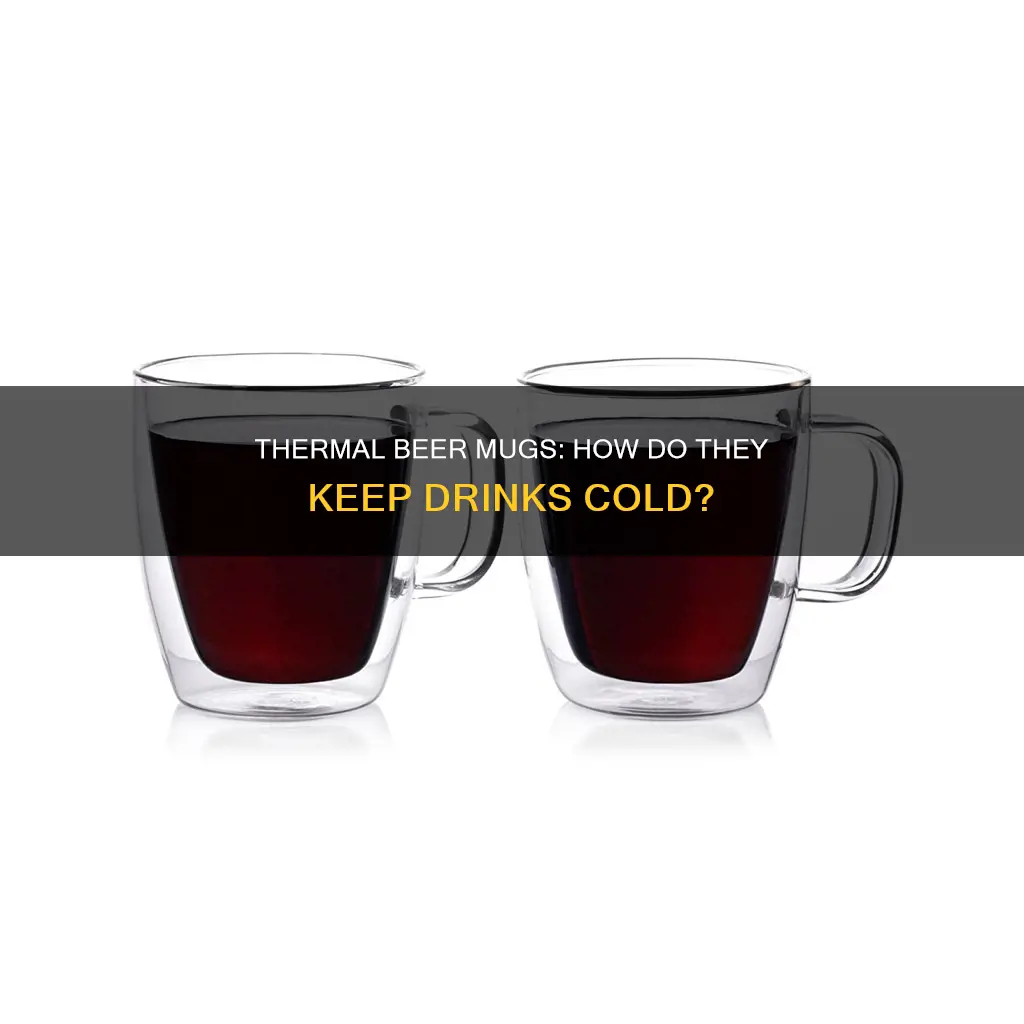
Thermal beer mugs, also known as insulated cups, are designed to keep your beer cold for longer. They usually feature double-walled vacuum insulation, which is a layer of empty space between two walls of material that prevents heat from escaping or entering the mug. This, in turn, maintains the temperature of the drink inside. The vacuum layer stops heat transfer from occurring, as heat can only be transferred from molecule to molecule when they are in close proximity. By eliminating air molecules, there is no way for heat to enter or exit the mug, and your beer stays cold.
| Characteristics | Values |
|---|---|
| Types of Insulation | Foam, Air, Vacuum, Copper |
| Purpose | Eliminate condensation, maintain beverage temperature |
| Material | High-quality double-walled stainless steel |
| Heat Transfer | No heat transfer through air, maintains drink temperature |
| Beverage Temperature | Hot drinks stay hot, cold drinks stay cold |
| Beverage Types | Coffee, tea, wine, beer, soft drinks, etc. |
| Mug Types | Coffee mugs, travel mugs, wine glasses |
| Mug Capacity | Up to 18 ounces of liquid |
| Mug Cost | $20-$40 depending on the brand |
| Vacuum Insulation | Layer of empty space between two walls of material |
| Heat Conduction | Transfer of heat from higher to lower temperature objects |
| Convection | Transfer of heat through fluids (liquids or gases) |
| Radiation | Transfer of heat through emission and absorption of heat waves |
What You'll Learn

Vacuum insulation prevents heat transfer
Vacuum insulation is a highly effective method of preventing heat transfer, a process that occurs in three main ways: conduction, convection, and radiation.
Conduction is the transfer of heat through direct contact between two objects at different temperatures. In a vacuum, the absence of air molecules eliminates the possibility of conduction as there is no medium through which heat can be conducted.
Convection, on the other hand, involves the movement of fluids or gases to transfer heat. With no air or gas molecules present in a vacuum, convection cannot occur.
Radiation is the transfer of energy in the form of electromagnetic waves. While radiation can occur in a vacuum, the vacuum space acts as a barrier, reflecting and absorbing radiant heat, thus preventing heat transfer.
Vacuum insulation takes advantage of these principles to create an insulating barrier that minimizes heat transfer. By evacuating the air from between two walls, conduction and convection are virtually eliminated, and the vacuum space reflects and absorbs radiant heat, preventing it from entering or escaping. This technology is commonly used in beverage containers to maintain the desired temperature of drinks for extended periods.
The effectiveness of vacuum insulation is evident in its ability to maintain the temperature of both hot and cold drinks. For example, a vacuum-insulated tumbler can keep a cold beer chilled for up to 9 hours, while a hot beverage can remain hot for up to 6 hours. This makes vacuum insulation superior to other types of insulation, such as foam or air insulation.
The key to the success of vacuum insulation lies in its ability to create a vacuum, which significantly reduces the thermal conductivity of the air. By removing the air, the vacuum layer makes it difficult for heat to be conducted or transferred, thus preventing heat escape or entry. The combination of the vacuum layer with the insulating properties of the container's materials, such as stainless steel or glass, ensures that the temperature of the contents remains stable.
Beer Trading: How Does It Work?
You may want to see also

Double-walled structure keeps drinks hot
Thermal mugs, or insulated tumblers, are designed to keep your drinks hot or cold for longer. The double-walled structure is key to achieving this.
The double-walled structure consists of two layers of steel or glass with an empty space between them. This space is highly evacuated to remove all the air, creating a vacuum. This vacuum layer makes it difficult for heat to escape or enter the mug, thus helping to maintain the temperature of the liquid inside.
The double-walled structure is particularly effective at preventing heat loss through conduction and convection. Conduction occurs when heat is transferred between two objects or liquids that are touching. In the case of a thermal mug, the vacuum layer prevents conduction by eliminating the possibility of an external object touching the liquid or the inner wall of the mug. Convection, on the other hand, is the transfer of heat through the movement of fluids (liquids or gases). The vacuum layer in a thermal mug prevents convection by stopping external air from coming into contact with the hot liquid.
The double-walled structure also helps to maintain the temperature of cold drinks. It prevents external heat from entering the mug and warming the liquid inside.
Overall, the double-walled structure of thermal mugs is an effective way to keep drinks hot or cold for extended periods. By creating a vacuum between two layers of material, the mugs are able to significantly slow down the transfer of heat.
Sprite vs Beer: A Healthy Alternative?
You may want to see also

Airtight lids prevent heat loss
The science behind thermal mugs lies in their ability to maintain the optimal temperature of your drink. This is achieved through various mechanisms that work together to prevent heat loss. One key mechanism is the double-walled construction, which acts as a thermal barrier by creating a vacuum chamber. This vacuum seal is crucial as it eliminates the presence of air molecules that would otherwise facilitate heat transfer through conduction.
The airtight lid of a thermal mug plays a pivotal role in preventing heat loss. When the lid is securely sealed, it prevents the escape of hot air, which could cool down the beverage. Additionally, the lid acts as a barrier, preventing the ingress of cooler air currents that could lower the temperature of the drink. This combination of an airtight lid and vacuum-sealed construction ensures that the temperature of the beverage remains constant, whether it's a hot cup of coffee or a chilled beer.
The effectiveness of the airtight lid is evident in the ability of thermal mugs to maintain the desired temperature for extended periods. The absence of air molecules within the vacuum chamber minimizes heat transfer, resulting in superior thermal retention. This means that your hot drinks will stay piping hot for several hours, and your cold drinks will remain chilled. The airtight lid works in tandem with the vacuum-sealed construction to create an insulated environment, maximizing the heat retention capabilities of the thermal mug.
The design of the airtight lid also contributes to its functionality. Some lids have a screw-on mechanism, providing a secure seal that minimizes heat loss during transportation. Other lids feature a flip-top design, offering convenience and quick access to the beverage. While these lids may not provide as tight a seal as screw-on lids, they still play a role in preventing heat loss. Ultimately, the airtight lid is an essential component of thermal mugs, working in conjunction with the double-walled construction to prevent heat loss and maintain the optimal temperature of your drink.
Hoppy Beers: The Secret to Better Beer Bread?
You may want to see also

Stainless steel reflects heat radiation
Thermal mugs, or insulated mugs, are designed to keep drinks cool or hot for extended periods. They achieve this through insulation, which prevents heat transfer. There are several types of insulation, including foam, air, and vacuum insulation. Vacuum insulation is considered the best for maintaining beverage temperature.
Vacuum-insulated mugs are constructed with double-walled stainless steel, with a vacuum layer between the two walls. This design serves to prevent heat from escaping and cold from entering. The stainless steel used in these mugs is typically of a grade called 18-8 or SUS304, which is widely used in food containers and kitchen products due to its good corrosion resistance, recyclability, and environmental protection qualities.
The key property that makes metals effective at reflecting thermal radiation is the presence of a large number of free-moving electrons. These electrons can quickly and easily interact with the electromagnetic fields present in thermal radiation, resulting in a strong reflection. This reflection prevents the thermal radiation from escaping or entering the mug, helping to maintain the desired temperature of the beverage inside.
In addition to reflecting heat radiation, stainless steel also has high thermal conductivity, which is useful in certain applications. For example, it is used in cookware and hot water tanks because it heats up evenly and quickly without forming hotspots. However, in the context of thermal mugs, the high thermal conductivity of stainless steel could be a disadvantage if it were not for the vacuum layer between the double walls. The vacuum layer prevents direct contact between the stainless steel walls and the beverage, reducing heat transfer through conduction.
Lovastatin and Beer: A Safe Mix?
You may want to see also

Vacuum layer stops heat flow
Vacuum-insulated mugs, also known as vacuum-sealed or insulated mugs, are designed with a double-walled structure, typically made of stainless steel. The space between these two walls is where the magic happens – it's evacuated to create a vacuum. So, how does this vacuum layer keep your drink's temperature steady? Let's dive into the science behind it.
Firstly, we need to understand how heat travels. There are three main ways: conduction, convection, and radiation. Conduction occurs when objects touch, and heat moves from the hotter object to the cooler one. In a vacuum, as there are no particles, conduction is prevented. Convection, on the other hand, doesn't need direct contact. It happens when thermal energy is carried by a fluid, like air. However, since a vacuum has no air, convection cannot occur.
Now, let's apply this understanding to our vacuum-insulated mugs. The vacuum layer between the two walls successfully stops both conduction and convection. Additionally, the lid of the mug plays a crucial role in maintaining the vacuum and preventing convection by not allowing air to enter or leave the mug.
But what about radiation? Well, that's where the reflective interior coating of the mug comes into play. Radiation is heat energy emitted by any object above absolute zero temperature. In the context of your drink, the hot liquid emits radiation in the form of heat. The reflective coating inside the mug bounces this radiation back, keeping the heat within the liquid.
So, there you have it! The vacuum layer in your thermal beer mug, along with the lid and reflective coating, work together to prevent conduction, convection, and radiation, resulting in your beer staying nice and cold, or your coffee piping hot for hours.
Wet Paper Towel on Beer: Does This Method Work?
You may want to see also
Frequently asked questions
A thermal beer mug is a type of insulated cup designed to keep your beer cold for longer. They are usually made from stainless steel with double walls and a vacuum layer between them.
The vacuum layer between the double walls of a thermal beer mug prevents heat transfer, keeping the beer cold. The vacuum layer stops heat conduction, convection and radiation.
Thermal beer mugs are great for keeping your beer cold for longer, especially if you are travelling or hosting a party. They also protect your fingers from frostbite and are environmentally friendly as they reduce the need for single-use plastics or cups.
Thermal beer mugs are typically made from 18-8 stainless steel, also known as SUS 304. This material is widely used in food containers and kitchen products due to its good corrosion resistance, recyclability and environmental protection properties.







